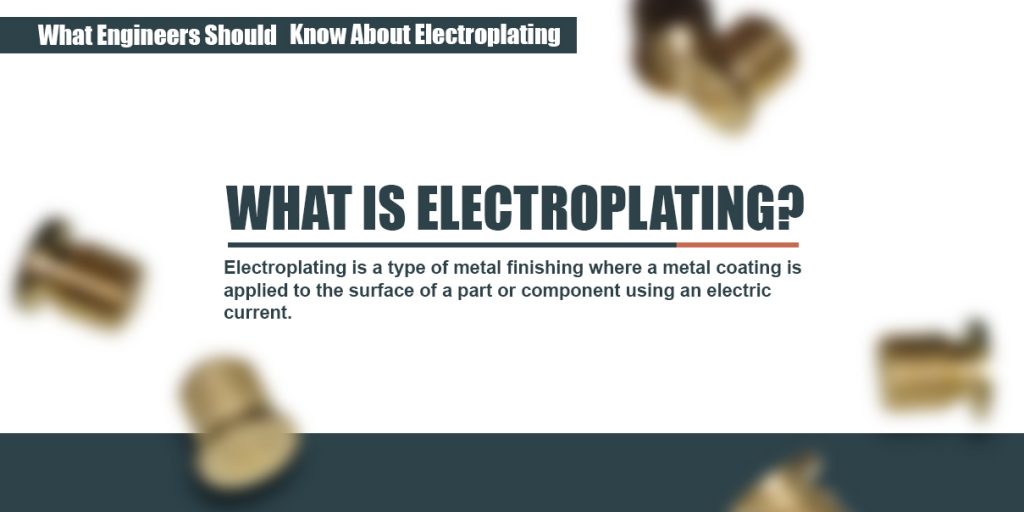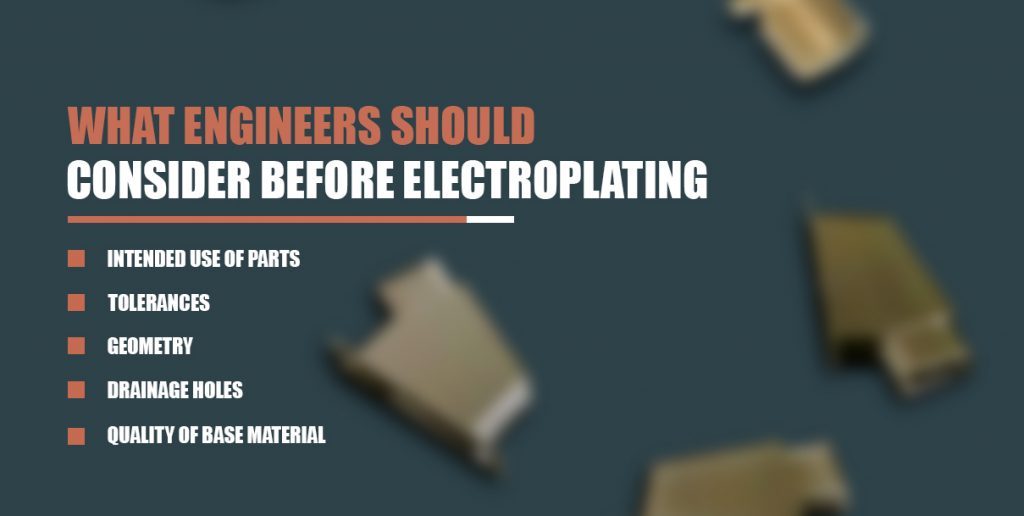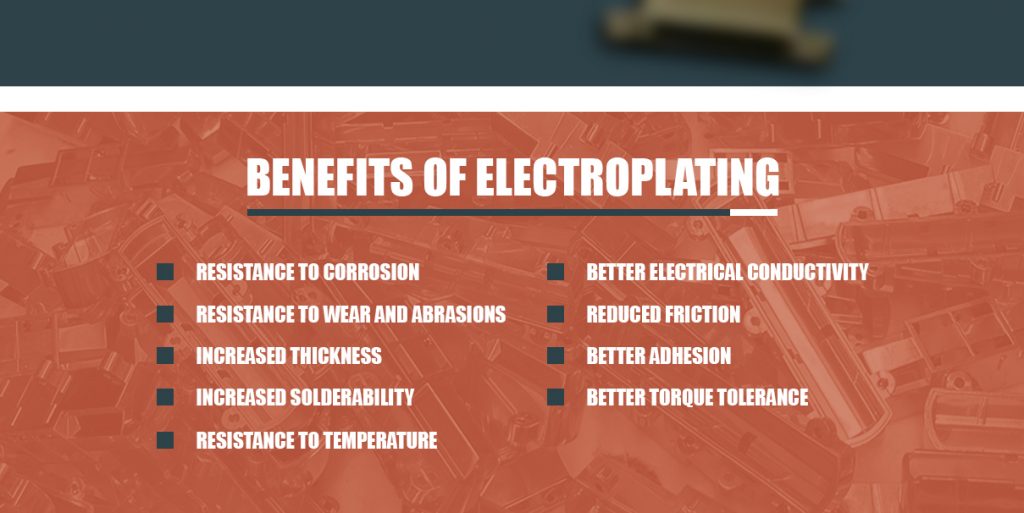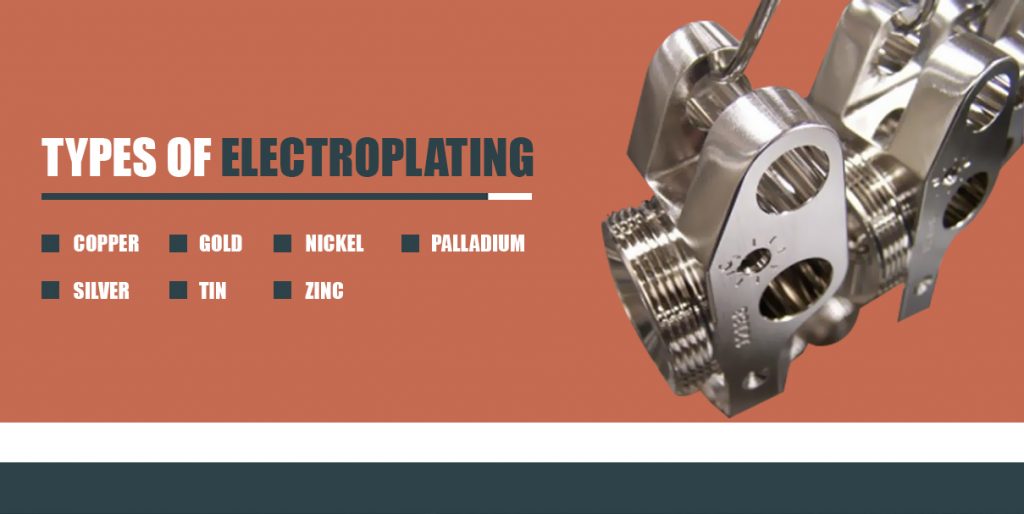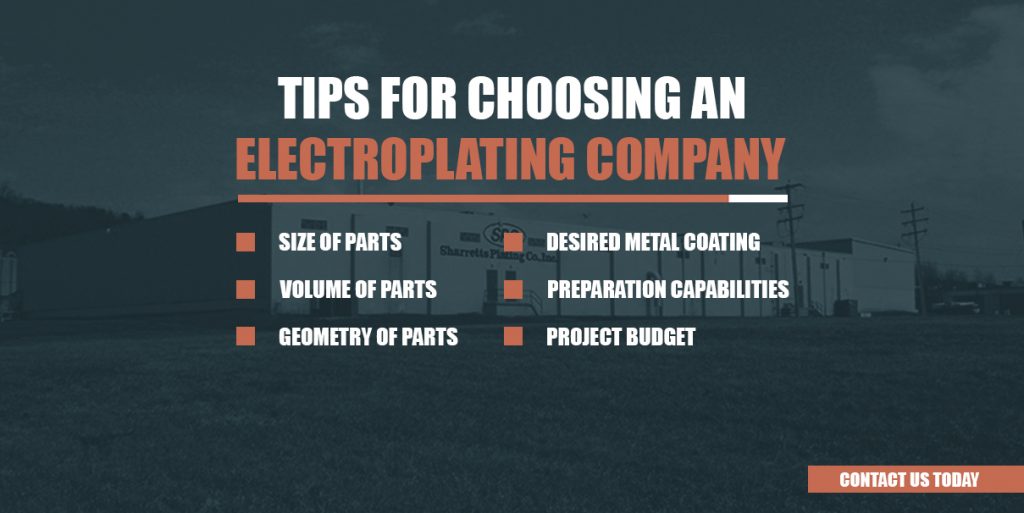Electroplating has become an important technology in many industries, as metal coating can improve performance and durability of parts. Electroplating can be applied to a wide variety of materials to provide numerous benefits, such as better conductivity, resistance to wear and durability in extreme temperatures. Electroplating of parts can produce a better final product with improved longevity. Before diving into electroplating for your next engineering project, it is helpful to have a base knowledge of how electroplating works, the various types available and the benefits it has.
What Is Electroplating?
Electroplating is a type of metal finishing where a metal coating is applied to the surface of a part or component using an electric current. The part or component, also called a substrate, is submerged in an electroplating bath and connected to a negatively charged electrode, also called a cathode. The plating metal is connected to the positively charged electrode, also known as an anode. When the electrical current is applied to the circuit, the ions in the coating are oxidized into the bath and deposited onto the substrate. This process is also called electrodeposition, as metal ions are deposited onto the substrate in a thin layer or coating.
Many components of the electroplating process must be carefully calculated to achieve the best results. Before submerging the substrate, it must be cleaned and processed in chemical baths that help to activate the surface of the parts. This ensures a strong bond will be created between the substrate and coating to produce good adhesion. The temperature and chemical composition of the electroplating bath must also be monitored during the process. The electrical current must be applied at the proper voltage and for the adequate duration of time.
Electroplating has applications in a wide variety of industries, including electronics, automotive, aerospace, medical, optics and oil and gas. While specific uses vary by sector, electroplating is generally used to improve the performance or appearance of a product or to protect it from wear. In the engineering field, electroplating has many benefits, including preventing corrosion, increasing conductivity and improving the durability of parts.
What Engineers Should Consider Before Electroplating
With many types and methods of electroplating available, you must determine the right process for the size and volume of parts you have. To achieve the best results with your electroplating, engineers should first consider a few important factors:
- Intended Use of Parts: Your end performance goals will determine the right type of electroplating for your parts, as different types of metal plating provide various benefits. You should also consider the environment in which your finished product will be used. If your parts are exposed to excessive wear or corrosive environments, these factors should also influence the type of coating you choose.
- Tolerances: Because electroplating involves depositing a layer of metal on the surface of a part, be sure to account for this change in dimension by providing tolerances. Consider the complete assembly to determine the appropriate plating thickness.
- Geometry: The shape and configuration of the parts will impact how evenly the metal coating can be distributed. Different areas will have higher or lower current density, which causes thicker or thinner plating. Corners and edges will have higher current density and thus have higher plating thickness than recesses and cavities. Consider this when designing your parts and planning for final plating thickness.
- Drainage Holes: Deep cavities or holes in parts can cause air to become trapped when the element is submerged into the electroplating solution. This can prevent the coating from adhering properly or create areas of thinner plating. Holes can also catch chemicals or solution during the cleaning process, which has the same adverse effect on the final result. To prevent the trapping of air or solution, drainage holes or weep holes can be added to the design of a part to allow air to escape, so electroplating solution can enter and coating can be appropriately distributed.
- Quality of Base Material: While metal coating can improve the appearance of parts or products, it is not intended to cover scratches or marks on the substrate. Mechanical finishing should be completed before electroplating. Additionally, if a part has an incomplete weld, this may lead to chemicals or air becoming trapped. Make sure parts are adequately welded or remove weld flux before electroplating your parts.
The last and most crucial component to consider is the best method of electroplating for your product. Depending on the size, quantity and durability of your parts, different means of electroplating will be more effective. Generally, there are two primary processes of electroplating
Batch plating is useful for smaller, durable parts that are not likely to be damaged by coming in contact with other parts. A common form of batch plating is barrel plating, in which parts are loaded into a cylinder filled with a solution that rotates to coat the parts. This method produces an even and consistent coating and is typically the most affordable and efficient option. Barrel electroplating is also valid for coating a variety of different sized and shaped parts at the same time. One risk of barrel plating is that very thin and smooth parts are prone to stick together during the process, preventing even coating. This can be mediated by adding ridges or dimples to small parts whenever possible.
For larger, more fragile or complex parts, rack plating is more effective. In this method, parts are placed on a rack or other fixture and lowered into the solution. Each component must be in contact with a pin or wire that contacts the electrical power source directly. Areas where the fixture comes in contact with the part will not be coated, so electroplating companies aim to design racks that allow for minimum contact while holding the piece in place. While more expensive, rack plating is often the best option for parts that could be damaged during rotation in a barrel.
A third option for applying metal plating is electroless plating. This option works best if you do not want to submerge your parts in liquid and submit them to electricity. In electroless plating, the metal coating is adhered using a chemical reaction instead of an electric current.
When designing parts, consider how the electroplating process will alter their dimensions and characteristics. Be aware that the original shape, size and quality of your parts also influences the final results of electroplating. When products are appropriately designed and prepared for electroplating, a consistent and effective metal coating can be applied.
Benefits of Electroplating
As an engineer, you know high-quality parts are essential to building a high-quality machine. Adding metal plating to your parts can improve their durability and performance or alter their characteristics by increasing conductivity or reducing friction. Electroplating can provide numerous benefits that have made it invaluable in engineering and many other industries. Below are just a few of the benefits of adding a metal coating to your parts through electroplating:
- Resistance to Corrosion: Electroplating can protect against corrosion and other atmospheric conditions and better withstand more extreme conditions. This allows parts with metal coating to last longer, so you can replace them less often.
- Resistance to Wear and Abrasions: Metal coating adds a protective layer that improves resistance to abrasions and wear. Plated parts are less likely to be damaged when dropped, and brittle parts become more durable after electroplating. The metal coating will also dissolve or disintegrate before the base material, which allows the substrate it to retain its quality longer.
- Increased Thickness: For manufacturing processes that require extreme thickness, metal coating can be used. Palladium is a popular choice for increasing the thickness of parts. Added thickness also leads to more durability and increased lifespan.
- Increased Solderability: Adding metal plating to a substrate can make it easier to solder, which is beneficial when a metal with low solderability is desired for a specific project.
- Resistance to Temperature: Electroplating with metals such as zinc-nickel or gold can protect the substrate against extremely high temperatures that machine or engine parts can be subjected to. This prevents heat damage and increases the longevity of parts.
- Better Electrical Conductivity: Electroplating with highly conductive metals, such as silver, can increase the conductivity of connectors or wires. This is an important application in the electronics industry or for other electrical components.
- Reduced Friction: Friction in electrical connectors and other parts can cause excess heat and wear. Electroplating with metals such as nickel can reduce friction to prevent wear and tear on parts.
- Better Adhesion: Some metal coatings, such as copper, provide an undercoating that allows for better adhesion of paint or additional levels of coating. This, in turn, leads to improved surface uniformity and finish appearance of the final coating.
- Better Torque Tolerance: Electroplating can strengthen a substrate, so it becomes more tolerant to torque without breaking or becoming damaged. This can be beneficial in machine parts that experience a lot of strain.
Types of Electroplating
Depending on your desired result and the characteristics that are most important for your project, there are a wide variety of metal coatings you can apply using electroplating. Specific coatings are also more compatible with particular base materials, so be sure to choose a coating that will adhere properly to your substrate. Below are some of the main types of electroplating, their primary uses and the benefits of choosing them for your electroplating:
- Copper: Copper is a flexible and highly conductive metal that often serves as a plating layer before a final metal layer is added, as well as for metallization of non-metallic parts. Copper is frequently used for electroplating for electronic parts, as well as in the aerospace and defense industries. Copper plating is effective for improving conductivity, adding thickness, protecting against corrosion and heat treatment stop-off.
- Gold: Because gold is a precious metal, it can be more costly than electroplating with other materials — however, there are many great reasons to choose gold for your electroplating. Gold is highly conductive, protects against high heat, prevents corrosion and is resistant to wear. For aesthetic applications, such as jewelry, gold provides a bright and attractive finish. Gold is often the best choice for electroplating of semiconductors, circuits and connectors.
- Nickel: Due to its wear resistance and resistance to corrosion, nickel is a popular metal for electroplating. Nickel plating increases product longevity and can be applied to steel as a substitute for more expensive stainless steel. Nickel can also be used to increase product thickness and reduce friction. The telecommunications and electronics industries often utilize nickel plating.
- Palladium: While palladium is a precious metal, it is more affordable than gold for electroplating. Palladium is also harder than gold, while still providing a bright and lustrous finish. Palladium also offers excellent protection from wear and corrosion, as well as being magnetic and solderable. Plating with palladium is often used during the manufacture of catalytic converters to absorb excess oxygen. Palladium is also popular in the electronics industry, as well as medical and dental product manufacturing.
- Silver: Silver is another precious metal that is popular for electroplating and very applicable in the electronics industry. Silver is highly conductive of both electricity and heat, resistant to corrosion and is stronger than gold. Silver electroplating is used in solar panel manufacturing, as well as the electronics and telecommunications industries.
- Tin: Tin is a cost-effective alternative to more expensive plating materials, while still providing corrosion resistance and easy solderability. Tin is primarily used in the electronics industry and the manufacturing of hardware products. However, tin is soft compared to other coating metals, and it’s also prone to producing small sharp protrusions called “tin whiskers.”
- Zinc: Zinc is another popular coating metal when affordability is the focus. Zinc is an excellent choice for improving adhesion, and it is also compatible with a wide variety of base metals. Zinc is also commonly a component in metal alloys used for electroplating, including zinc-nickel.
These are just a few of the options for different types of electroplating. Many alloys are also available that blend multiple metals or a metal and another substance. If you are not sure what the best coating is for your particular application, your electroplating company may be able to guide you toward the best metal finishing for your product.
Tips for Choosing an Electroplating Company
When choosing an electroplating company to work with, be sure to have in mind the type of coating you want to use and your desired electroplating method. Look for a company that can provide the right services for you and properly protect your parts from damage during the process. Here are a few other important factors to consider when selecting an electroplating company:
- Size of Parts: If applying metal coating to large parts, be sure your electroplating company has a feasible electroplating method and rack system that is large enough to accommodate them. Small parts can typically be coated using a barrel plating method, however, if you have fragile parts to coat, you should seek an electroplating company that can secure them effectively and safely for rack plating.
- Volume of Parts: Batch electroplating is often a more affordable option because a large number of parts can be coated in each batch. Seek an electroplating company that has the capabilities to accommodate the number of pieces you want to coat.
- Geometry of Parts: Electroplating on parts that are unusual or complex shapes may require a custom fixture to be designed for rack plating to avoid damaging the parts while still applying metal coating effectively. Wiring may also be used to connect parts effectively. Look for a company that can adjust to your specific needs.
- Desired Metal Coating: Verify that your electroplating company can provide the type of metal coating you desire for your project. You may also want to consider potential future projects, so you will not need to change electroplating companies if they cannot provide the correct metal coating that you need down the road.
- Preparation Capabilities: Many electroplating companies focus solely on electroplating, but neglect to provide excellent preparation and pre-treatment services. Cleaning and treatments before electroplating have a significant influence on how well the coating adheres and the overall quality of the final product. Seek an electroplating company that can properly clean and prepare your parts before electroplating.
- Project Budget: Before committing to an electroplating company, discuss the options available for your project to find the right solution that works with your budget.
Work With SPC for Your Electroplating Needs
Whether you are seeking to strengthen your parts or improve their performance, Sharretts Plating Company can provide the right electroplating type and methods to suit your project. Our expert team will work with you to determine the proper metal coating for your needs and budget. If your project involves large or unusually shaped parts, we can create a custom rack or wiring system to ensure your parts are plated effectively and safely.
Contact us today to learn more about electroplating with SPC or request a quote for your electroplating project.


